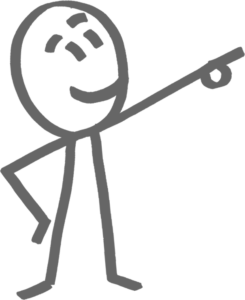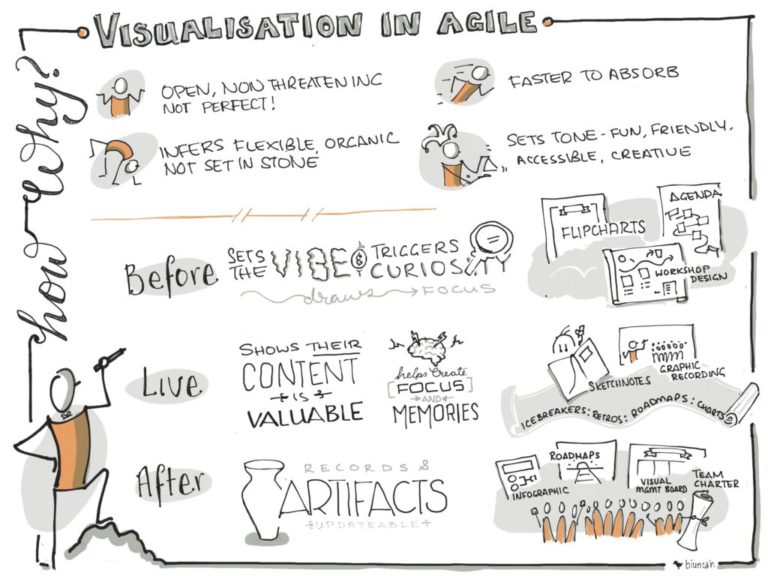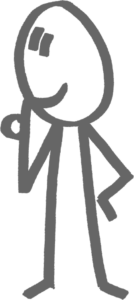









Business Agility / Transformation Coach
![]() As a facilitator, I consider it really important to capture and present the participants’ content in a way that’s valuable to them. There are many workshops out there, but how you are going to make yours different, how will you make people’s content and ideas memorable? Through a better workshop, you get a better outcome so you can increase productivity, energy and communication in an organisation.
As a facilitator, I consider it really important to capture and present the participants’ content in a way that’s valuable to them. There are many workshops out there, but how you are going to make yours different, how will you make people’s content and ideas memorable? Through a better workshop, you get a better outcome so you can increase productivity, energy and communication in an organisation.
We could have almost replaced Biunca’s story with her brilliant poster. She created it in response to our interview request to talk about the role of visualisation in her work. “I wanted to get a bit of perspective down on paper about why I thought visualisation was important. Because at the end of the day, what better way to talk about the visualisation than to visualise it.”
Biunca came across Visual Friends last year and did both the Basic and Advanced Visual Storytelling course. But her visualisation journey started well before that.
She always enjoyed drawing. “I was probably always the kid in class who’d prefer to draw in the corner, rather doing math or writing. “
As Biunca moved into her working career the skill proved to be useful. “I found it was often easier to sketch out the problem and talk to people through the sketch to get a good understanding of the issue.”
As Biunca’s career progressed from facilitation to Agile ways of working, her visualisation skills continued to change too. Sketching moved from a notepad onto a wall, Biunca began to use Sketchnoting and even scribed for a few conferences. “I realised there’s more to learn about visualising effectively. I was also wondering if I was really maximising the technique.”


Visualisation in Agile
Biunca Hooper
Enter Visual Friends.
One of the personal challenges was visualising effectively in a larger format. Biunca thought sketching on A4/A5 didn’t present a lot of risks and wanted to challenge herself. “I wanted to understand how to fill a big flipchart, how to balance the real estate on a page and quickly add hand-drawn images. Those things I found really valuable.”
Learning about the best way to hold a marker, how to get ink consistency to form your pen and how to streamline your poster handwriting was unexpected but welcome knowledge. “I often get compliments now about my handwriting on posters, the course really improved my technique.”
To further refine her skills Biunca followed up the bikablo® fundamentals class with the Advanced course.
![]() It provided a different perspective – bringing visualisation to life through storytelling, a powerful tool from the facilitation perspective.
It provided a different perspective – bringing visualisation to life through storytelling, a powerful tool from the facilitation perspective.
Biunca believes the course changed her visualisation style and allowed her to use the skill in her work with more confidence. “If you looked at the before and after photos my work, you’d definitely see the difference in style, and probably the number of flipcharts and visualisations that I was doing increased as well.”
The Visual Friends course also allowed Biunca to strengthen her facilitation and Agile coaching tool kit. “I guess what the course enabled me to do is to really apply my skills in a much broader range of workshopping activities.”
Biunca runs workshops all the time and uses visualisation on a daily basis. She truly believes it contributes to a better-quality outcome. “As a facilitator, I consider it really important to capture and present the participants’ content in a way that’s valuable to them. There are many workshops out there, but how are you going to make yours different, how will you make people’s content and ideas memorable? Through a better workshop, you get a better outcome so you can increase productivity, energy and communication in an organisation.”
Creating value for her clients is one of the most satisfying parts of Biunca’s work, and visualisation really supports that. “I love seeing participants excited about the way their content has been captured. It’s a takeaway item that people can keep or share with others, something they are proud of. For me, it’s one of the most important things.”
Biunca believes visualisation supports culture change in an organisation. “People tend to interact in front of visualised content, you have more conversations, it creates more energy. If you go from a very stark environment with very few posters or post-it notes around to a visual way of working where there are containers and objects for people to put content into, really awesome sketches of workshops showing progress and highlighting things, it indicates a real change in the style of communication.”
Biunca would love to see more organisations take on visual ways of working as the benefits speak for themselves. “It’s around encouraging everyone to visualise because I think people get so caught up in trying to communicate through words alone, through e-mail and ineffective meetings. How do we bring in visualisation as a key communication and collaboration tool, not a sideline or executable outcome? How do we do it by design? Literally.”

The article was written by Natalia Tsygankova. Natalia has always loved words and talking to people. She has put that passion to good use and has been sharing people’s stories in the community radio, TV and print media for the last 10 years. Natalia is also a big fan of true storytelling events and regularly volunteers at the most famous one – The Moth, interviewing the winner. You can hear her own story of moving to Australia from Russia in 1999 here. Natalia believes that everyone has a story – So what’s yours? Contact her today to share your story.

